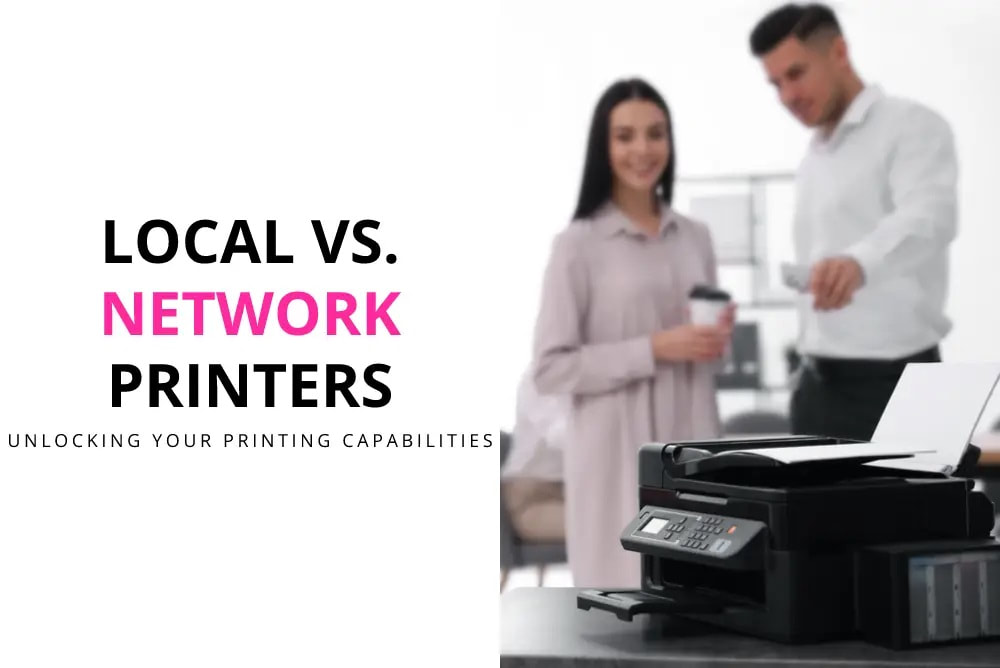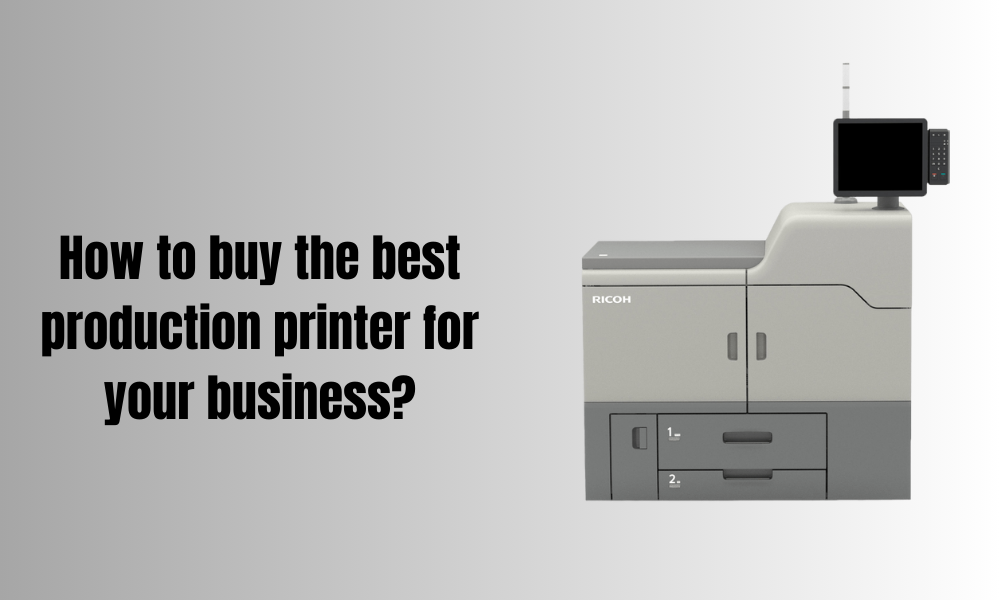Local vs Network Printers and How Your Business Can BenefitLocal and network printers serve different purposes, and each has its advantages based on the specific needs of your business. Let's explore the distinctions between local and network printers and how your business can benefit from each:
Local Printers / USB Printer: 1. Definition: - A local printer is directly connected to an individual computer or workstation. It is typically connected via USB, parallel port, or other direct cabling. 2. Advantages: - Simplicity: Local printers are easy to set up and manage, making them suitable for small offices or individual users. - Cost-Effective: Local printers tend to be more budget-friendly, making them a practical choice for businesses with limited printing needs. 3. Use Cases: - Local printers are often suitable for personal or low-volume printing tasks. They are commonly found in home offices, small businesses, or situations where a single user requires dedicated access to a printer. 4. Considerations: - Limited Sharing: Local printers are designed for individual use and are not easily shared among multiple users without additional configuration. - Scalability: As your business grows, adding more local printers to accommodate increased printing needs may become impractical. Network Printers: 1. Definition: - A network printer is connected to a local area network (LAN) and can be accessed by multiple users across the network. They can use various connectivity options, such as Ethernet or wireless. 2. Advantages: - Shared Access: Network printers can be shared by multiple users, facilitating efficient resource utilization and reducing the need for individual printers at each workstation. - Centralized Management: Network printers can be centrally managed, allowing administrators to monitor usage, configure settings, and apply updates from a central location. - Scalability: Network printers are scalable and can easily accommodate the growing printing needs of a business by serving multiple users simultaneously. 3. Use Cases: - Network printers are ideal for businesses with medium to large workforces, where multiple users need access to a single printing resource. They are commonly used in office environments where efficiency and cost-effectiveness are essential. 4. Considerations: - Initial Investment: Network printers may have a higher upfront cost compared to local printers. However, the shared access and centralized management can contribute to long-term cost savings. - Network Infrastructure: Reliable network connectivity is crucial for the effective operation of network printers. Ensure that your business has a stable and well-maintained network infrastructure. How Your Business Can Benefit: 1. Efficiency and Productivity: - Network printers enable multiple users to share a single printing resource, reducing the time spent waiting for a local printer to become available. 2. Cost Savings: - While network printers may have a higher initial investment, the shared access and centralized management often result in cost savings over time compared to deploying multiple local printers. 3. Centralized Control: - Administrators can manage and monitor network printers centrally, simplifying configuration, troubleshooting, and updates. 4. Scalability: - Network printers are easily scalable to accommodate the growing printing needs of a business, making them suitable for businesses with expanding workforces. 5. Collaboration: - Network printers facilitate collaborative work environments by allowing multiple users to print, scan, or copy documents efficiently. 6. Flexibility: - With network printers, users can access printing resources from different devices and locations within the office, providing flexibility in how and where work is conducted. Ultimately, the choice between local and network printers depends on the size and requirements of your business. Small businesses with limited printing needs may find local printers sufficient, while medium to large enterprises benefit from the shared access and centralized management capabilities of network printers. In some cases, businesses may use a combination of both types of printers to meet various printing needs across the organization.
0 Comments
Factors Affect Buying a Digital Press Production PrinterChoosing the right production printer for your business involves careful consideration of various factors to ensure that the selected device meets your specific needs and objectives. Here are key factors to consider when buying a production printer:
1. Printing Volume: - Determine your expected monthly printing volume. Production printers are designed for high-volume printing, so choose a device that can handle the quantity of prints your business requires. 2. Printing Speed: - Assess the printing speed of the production printer, measured in pages per minute (ppm). Higher speeds are beneficial for businesses with demanding printing requirements. 3. Print Quality: - Evaluate the print quality, resolution, and color accuracy. For certain applications, such as marketing materials or graphic design, high print quality is crucial. 4. Media Handling: - Consider the types and sizes of media the printer can handle. Production printers should support various paper weights, sizes, and types, including specialty media such as envelopes or cardstock. 5. Finishing Options: - Explore the finishing options available, such as stapling, binding, folding, and hole-punching. Finishing capabilities can enhance the final presentation of printed materials. 6. Workflow Integration: - Assess the production printer's compatibility with your existing workflow and systems. Look for features such as seamless integration with document management software or print management solutions. 7. Connectivity and Compatibility: - Ensure that the production printer has the necessary connectivity options, including Ethernet, USB, and wireless capabilities. Compatibility with various operating systems is also essential. 8. Ease of Use: - Evaluate the user interface and ease of operation. A user-friendly interface can improve productivity and reduce the learning curve for your staff. 9. Reliability and Durability: - Consider the reliability and durability of the production printer. Look for devices with a solid reputation for performance and longevity, especially given the high-volume printing demands. 10. Service and Support: - Research the manufacturer's reputation for customer support and service. Look for warranty options and the availability of maintenance contracts. 11. Cost Considerations: - Consider the total cost of ownership, including initial purchase price, consumables (toner or ink cartridges, maintenance kits), energy consumption, and any additional costs associated with finishing options. 12. Security Features: - Assess the security features of the production printer. Given the sensitive nature of many printed documents, features such as secure printing, user authentication, and data encryption are important. 13. Environmental Impact: - Consider the environmental impact of the production printer. Look for energy-efficient models, eco-friendly features, and recycling programs for consumables. 14. Upgradability: - Evaluate whether the production printer can be upgraded or expanded to accommodate future business growth or changing printing requirements. 15. Vendor Reputation: - Consider the reputation of the manufacturer and vendor. Reviews, testimonials, and recommendations from other businesses can provide insights into the reliability and performance of the production printer. 16. Test Before Purchase: - Whenever possible, test the production printer with sample prints before making a final decision. This allows you to assess print quality, speed, and overall performance. By thoroughly assessing these factors, you can select a production printer that aligns with your business needs, enhances productivity, and provides a good return on investment for your high-volume printing requirements. |
AuthorFSM Solution Archives
December 2023
Categories |
- Home
- Online Store
-
Products
- Office Printer
- Interactive White Board
- FujiFilm Photocopy Machine
- Recondition Photocopier
- Production Printer
- A1 A0 Plan Printer
- Large Format Printer
- Large Format Scanner
- Document Scanner
- Fax Machine
- Projector
- Roll Sticker Label Cutter And Waste Removal
- Sheet & Roll Flatbed Cutter
- Production CNC Cutter
- Form Board Printer
- Art Card Printer
- Roll Art Card Printer
- Roll Sticker Printer
- T-Shirt Printer
- UV DTF Sticker Printer
- Software
- Services
- Support
- About Us
- Home
- Online Store
-
Products
- Office Printer
- Interactive White Board
- FujiFilm Photocopy Machine
- Recondition Photocopier
- Production Printer
- A1 A0 Plan Printer
- Large Format Printer
- Large Format Scanner
- Document Scanner
- Fax Machine
- Projector
- Roll Sticker Label Cutter And Waste Removal
- Sheet & Roll Flatbed Cutter
- Production CNC Cutter
- Form Board Printer
- Art Card Printer
- Roll Art Card Printer
- Roll Sticker Printer
- T-Shirt Printer
- UV DTF Sticker Printer
- Software
- Services
- Support
- About Us
Online Store
Product |
Services |
Authorized Sales & Services
|
Contact Us |
Copyright © 2024 FSM Solution Sdn Bhd. All Rights Reserved.



 RSS Feed
RSS Feed














